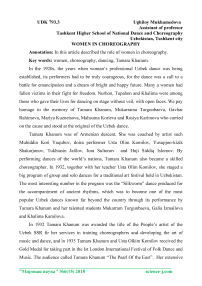Women in choreography
Автор: Mukhamedova U.
Журнал: Мировая наука @science-j
Рубрика: Основной раздел
Статья в выпуске: 6 (15), 2018 года.
Бесплатный доступ
In this article described the role of women in choreography.
Women, choreography, dancing, tamara khanum
Короткий адрес: https://sciup.org/140263674
IDR: 140263674
Текст научной статьи Women in choreography
In the 1930s Mukarram Turgunbaeva’s dances “Cotton picking” in the “Red Caravan” pantomime, “Removing the veil” in the “Shahida” Ballet, and “Gulsara” dance in the “Gulsara” musical drama were perceived as discovery and a call for woman’s freedom. Female characters created by Turgunbaeva in her dances of that time served as role models and ideals for Uzbek women. The profoundly national “Tanovar” dance she performed was preserved in a film. Mukarrama said: “My “Tanovar” was born in my heart the night after I saw the Dying Swan number in a concert. The impression was so strong, so overwhelming, that I couldn’t sleep all night and spent the next few days in a state of mental fever, until the “Tanovor”- the Uzbek Swan – rose in my heart.
In the “Tanovar” Turgunbaeva uses gestures and looks to show anxiety in the eyes of Uzbek women waiting for the news from their sons, father, and husbands fighting one the front line. Famous Russian artist I. M. Moskvin, after seeing her dance, said: “Tanovar is a song without words…, a talent to express oneself through gesture. In 1957 Mukarrama Turgunbaeva organized a dance company called “Bahor”. Together with Isohor Okilov, lead ballet-master of Uzbekistan, she brought together a group of girls who graduated from the Tashkent Shcol of Theatre and the Navoi opera and Ballet theatre. The company became a prize winner of many national and international contest. Since 1960 the “Bahor” has been called the State Dance Company of Uzbekistan. Turgunbaeva constantly worked on improving
Uzbek dance. Not only did she created new composition, she also introduced innovations into Uzbek choreography. State began to see a lot of group dances. Compositions created by Turgunbaeva tell about friendship, lifestyle, and the daily grin. These include “The Seven Beauties” poem, “Cotton” suite, and other pieces. The girls from the “Bahor” company performed the “Cotton” suit so masterfully by that the dance became a symbol of Uzbekistan’s performing art. “Many hand-and-arm movements of the Fergana dance grew out of day-to-day chores and labour, but dances “Generalized” them and found an artistic symbol for the gesture Remember the original hand movement in any Fergana dance when a soft hand closes and opens: take a close look at this move, divide it into elements a, and you will realized that it was born precisely out of cotton harvesting work”, Turgunbaeva wrote in her dairy. Folk songs and dances were given a new power and voice on stage. Turgunbaeva brought up hundreds of students, leaving behind a heritage of daces, which became the golden asset of choreographic art. The audience of today still love her group dances such as “Silkworm”, “Cotton”, “Bayot”, “Rohat”, “Katta uyin”, “The Apples of Namangan”, and “Rubai of Fergana ”, as well as solo dances “Havaskor”, “The Doll”,”Rohat” , “Tanovor”, “Munojot” and “Rubayat of Fergana”.
In the wake the “Bahor” company’s success, other follower companies appeared, such as “Uzbekistan”, “Tanovor”, “Lazgi”, and “Zarafshon”. Mukarrama Turgunbaeva is known not only as a great expert in oriental dance and dancing rhythms, but also as a genius performer, choreographer and pedagoguc who dedicated her life to the development of Uzbek dance.
Список литературы Women in choreography
- Авдеева Л. Танец Мукаррам Тургунбаевой. Ташкент 1989
- Каримова Р. Ферганский танец. Ташкент 1973
- Тамара Ханум. Ташкент 1956.


